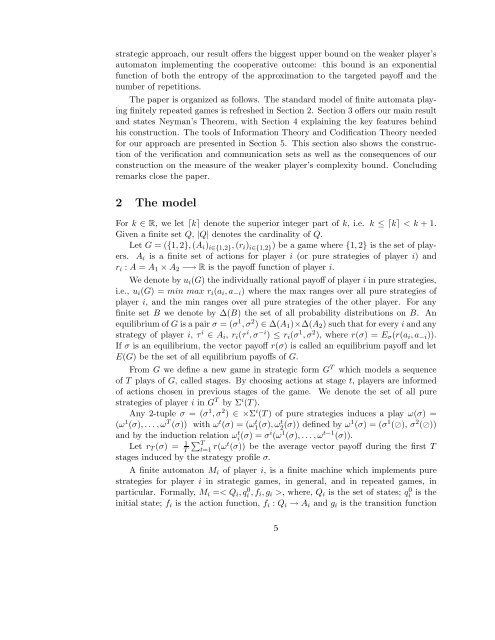CODIFICATION SCHEMES AND FINITE AUTOMATA ... - Ivie
You also want an ePaper? Increase the reach of your titles
YUMPU automatically turns print PDFs into web optimized ePapers that Google loves.
strategic approach, our result offers the biggest upper bound on the weaker player’s<br />
automaton implementing the cooperative outcome: this bound is an exponential<br />
function of both the entropy of the approximation to the targeted payoff and the<br />
number of repetitions.<br />
The paper is organized as follows. The standard model of finite automata playing<br />
finitely repeated games is refreshed in Section 2. Section 3 offers our main result<br />
and states Neyman’s Theorem, with Section 4 explaining the key features behind<br />
his construction. The tools of Information Theory and Codification Theory needed<br />
for our approach are presented in Section 5. This section also shows the construction<br />
of the verification and communication sets as well as the consequences of our<br />
construction on the measure of the weaker player’s complexity bound. Concluding<br />
remarks close the paper.<br />
2 The model<br />
For k ∈ R, we let ⌈k⌉ denote the superior integer part of k, i.e. k ≤ ⌈k⌉ < k + 1.<br />
Given a finite set Q, |Q| denotes the cardinality of Q.<br />
Let G = ({1,2},(A i ) i∈{1,2} ,(r i ) i∈{1,2} ) be a game where {1,2} is the set of players.<br />
A i is a finite set of actions for player i (or pure strategies of player i) and<br />
r i : A = A 1 × A 2 −→ R is the payoff function of player i.<br />
We denote by u i (G) the individually rational payoff of player i in pure strategies,<br />
i.e., u i (G) = min max r i (a i ,a −i ) where the max ranges over all pure strategies of<br />
player i, and the min ranges over all pure strategies of the other player. For any<br />
finite set B we denote by ∆(B) the set of all probability distributions on B. An<br />
equilibrium of G is a pair σ = (σ 1 ,σ 2 ) ∈ ∆(A 1 )×∆(A 2 ) such that for every i and any<br />
strategy of player i, τ i ∈ A i , r i (τ i ,σ −i ) ≤ r i (σ 1 ,σ 2 ), where r(σ) = E σ (r(a i ,a −i )).<br />
If σ is an equilibrium, the vector payoff r(σ) is called an equilibrium payoff and let<br />
E(G) be the set of all equilibrium payoffs of G.<br />
From G we define a new game in strategic form G T which models a sequence<br />
of T plays of G, called stages. By choosing actions at stage t, players are informed<br />
of actions chosen in previous stages of the game. We denote the set of all pure<br />
strategies of player i in G T by Σ i (T).<br />
Any 2-tuple σ = (σ 1 ,σ 2 ) ∈ ×Σ i (T) of pure strategies induces a play ω(σ) =<br />
(ω 1 (σ),... ,ω T (σ)) with ω t (σ) = (ω t 1 (σ),ωt 2 (σ)) defined by ω1 (σ) = (σ 1 (⊘), σ 2 (⊘))<br />
and by the induction relation ω t i (σ) = σi (ω 1 (σ),... ,ω t−1 (σ)).<br />
Let r T (σ) = 1 T<br />
∑ T<br />
t=1 r(ωt (σ)) be the average vector payoff during the first T<br />
stages induced by the strategy profile σ.<br />
A finite automaton M i of player i, is a finite machine which implements pure<br />
strategies for player i in strategic games, in general, and in repeated games, in<br />
particular. Formally, M i =< Q i ,q 0 i ,f i,g i >, where, Q i is the set of states; q 0 i is the<br />
initial state; f i is the action function, f i : Q i → A i and g i is the transition function<br />
4

















